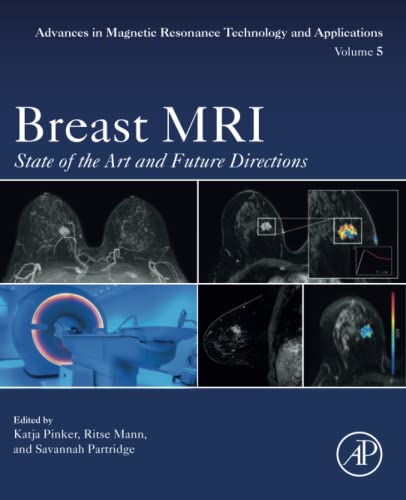Breast MRI State of the Art and Future Directions 1st Edition by Katja Pinker 012822729X 9780128227299
$50.00 Original price was: $50.00.$25.00Current price is: $25.00.
Breast MRI State of the Art and Future Directions 1st Edition by Katja Pinker – Ebook PDF Instant Download/Delivery: 012822729X, 9780128227299
Full download Breast MRI State of the Art and Future Directions 1st Edition after payment

Product details:
ISBN 10: 012822729X
ISBN 13: 9780128227299
Author: Katja Pinker
Breast MRI: State of the Art and Future Directions provides a comprehensive overview of the current applications of breast MRI, including abbreviated MRI, as well as presenting technical recommendations, practical implementation and associated challenges in clinical routine. In addition, the book introduces novel MRI techniques, multimodality imaging, and advanced image processing coupled with AI, reviewing their potential for impeding and future clinical implementation. This book is a complete reference on state-of-the-art breast MRI methods suitable for MRI researchers, radiographers and clinicians.
Breast cancer is one of the leading causes of death among women with early detection being the key to improved prognosis and survival. Magnetic resonance imaging (MRI) of the breast is undisputedly the most sensitive imaging method to detect cancer, with a higher detection rate than mammography, digital breast tomosynthesis, and ultrasound.
- Spans the whole spectrum of breast MRI, including basic imaging techniques, indications, interpretation, and the latest cutting-edge techniques
- Reviews multiparametric MRI and abbreviated protocols, providing an outlook on the future of this technique
- Discusses the predictive and prognostic value of MRI as well as the evolving field of radiomics/genomics and AI
Breast MRI State of the Art and Future Directions 1st Table of contents:
Part 1 State of the art
Section 1 Performance and interpretation of breast MRI
Chapter 1. Multiparametric breast MRI in clinical practice
Introduction
T1-weighted imaging
Standard dynamic contrast-enhanced MRI
T2-weighted imaging
Diffusion-weighted imaging
Other specific imaging sequences
Chapter 2. Abbreviated and Ultrafast MRI
Introduction
Abbreviated MRI protocols
Recent MRI screening studies
Benefits and challenges of abbreviated MRI
Ultrafast MRI (high temporal resolution MRI)
Hybrid imaging—abbreviated ultrafast MRI
Recent MRI screening studies
Conclusions
Chapter 3. Artifacts in breast MRI
Introduction
Motion artifacts
Fat
Susceptibility
Other artifacts
Conclusions
Chapter 4. Standard terminology and reporting– Breast Imaging Reporting & Data System: magnetic resonance imaging
Introduction
Standard terminology
Reporting
Conclusions
Chapter 5. The Kaiser score: an evidence-based clinical decision rule for dynamic contrast-enhanced breast MRI
Introduction: why do we need the Kaiser score in breast MRI?
Description of the Kaiser score and its criteria
The Kaiser score
Application of the Kaiser score in clinical practice
Conclusions
Chapter 6. Background parenchymal enhancement at breast MRI
Introduction
MRI appearance of BPE
BPE, breast density, and FGT
Biological basis of BPE
Factors influencing BPE
BPE and diagnostic performance
Qualitative and quantitative assessments of BPE
BPE and breast cancer risk
BPE and treatment outcomes
Conclusions
Section 2 MRI characteristics of common breast lesions
Chapter 7. MRI characteristics of benign lesions
Introduction
Developmental abnormalities
Fibroadenolipomas (hamartomas)
Lipomas
Leiomyomas and hemangiomas
Fibroadenomas
Phyllodes tumor
Cysts
Fibrocystic changes
Adenosis
Infectious and inflammatory conditions
Idiopathic granulomatous mastitis
Pseudoangiomatous stromal hyperplasia
Conclusions
Chapter 8. MRI characteristics of high-risk lesions
Introduction
Histopathological characteristics
Imaging findings at conventional imaging
Imaging findings at breast MRI
Management
New frontiers
Chapter 9. MRI characteristics of ductal carcinoma in situ
Introduction
Clinical presentations and pathologic features of DCIS
Appearance of DCIS on dynamic contrast-enhanced MRI
DCIS appearance on advanced MRI techniques
MRI performance to assess the extent of DCIS
Future directions: MRI to assess biology and prognosis
Conclusions
Chapter 10. MRI characteristics of invasive breast cancer
Introduction
Invasive ductal carcinoma
Invasive lobular carcinoma
Uncommon histologic subtypes of invasive breast cancer
Special presentations of invasive breast cancer
Conclusions
Section 3 Clinical indications for breast MRI
Chapter 11. Breast MRI for screening
Introduction
Screening in specific risk groups
Shortcomings of screening
Additional screening methods for women undergoing breast MRI
General guidance
Chapter 12. Breast MRI for staging and treatment planning
Introduction to the role of breast MRI
MRI for staging
Treatment planning
Impact of MRI on surgical outcomes
Conclusions
Chapter 13. Neoadjuvant therapy response assessment with breast MRI
Introduction
Pathologic measures of neoadjuvant therapy response
Dynamic contrast-enhanced MRI, diffusion-weighted imaging, and MR spectroscopy: correlation with pathologic complete response
Monitoring chemotherapy response in the axilla
Conclusions
Chapter 14. Breast MRI for post-treatment follow-up
Introduction
Posttreatment changes
Recurrent breast cancer
Chapter 15. Breast augmentation and postmastectomy autologous breast reconstruction on breast MRI
Introduction
Breast augmentation and implant-based reconstruction
Free silicone injection
Free-fat injection, lipofilling, lipomodeling, or autologous fat grafting
Autologous flaps
Latissimus dorsi flap
TRAM (transverse rectus abdominus muscle) flap
DIEP (deep inferior epigastric perforator) flap
Chapter 16. Problem-solving breast MRI
Introduction
Evaluation of suspicious symptoms, including nipple discharge
Equivocal imaging findings
Conclusions
Chapter 17. Imaging of the axilla and cancer of unknown primary
Introduction
Anatomy of the axilla
Spread of metastatic disease to axillary lymph nodes
Evaluation of axillary lymph nodes
MR imaging of the axilla
Detection of abnormal axillary lymph nodes on MRI
Clinical management of metastatic axillary lymph nodes
Radiotherapy
Chemotherapy
The controversial role of imaging in axillary staging
Role of MRI in the detection and treatment of occult primary breast cancer
Interventional techniques for axillary lymph node localization and breast MRI
Future directions
Conclusions
Section 4 Breast magnetic resonance imaging—guided interventions and therapy
Chapter 18. Biopsy, including MRI-directed US and rad-path correlation
Introduction
History of MRI-guided techniques
MRI-guided biopsy
Imaging review
Consent process, contraindications, and risk
Equipment
The procedure: positioning, protocol, percutaneous biopsy
MRI localization
MRI-guided clip placement with subsequent mammographic/sonographic localization
MRI-directed skin localization with subsequent excisional biopsy
MRI-guided wire localization
Wire-free MRI localization
MRI-directed ultrasound
Radiologic–pathologic correlation
Current challenges and future directions
Conclusions
Chapter 19. MRI-guided minimally invasive therapy of breast lesions
Introduction
State of the art and methodologies
Applications in breast care
Conclusions
Part 2 Future directions
Section 5 Advanced and emerging approaches
Chapter 20. Noncontrast MRI
Introduction
Diffusion-weighted MRI
DW MRI as a supplement to conventional DCE-MRI
DW MRI as a stand-alone modality
Image interpretation strategies
Technical considerations
Emerging techniques
Conclusions
Chapter 21. Metabolic imaging using ultra-high field MRI
Introduction
Applications
Challenges and future applications
Conclusions
Chapter 22. Quantitative DCE-MRI of the Breast
Introduction
Pharmacokinetic modeling of DCE-MRI data
Applications of quantitative breast DCE-MRI
Technical Considerations for Quantitative Breast DCE-MRI
Conclusions
Chapter 23. Diffusion MRI of the breast: standard and advanced techniques
Introduction
Diffusion-weighted imaging
Advanced diffusion MRI
Conclusions
Chapter 24. MR spectroscopy
Introduction
In vivo magnetic resonance spectroscopy technique
Data analysis
Clinical applications
Conclusions
Chapter 25. Emerging techniques in breast MRI
Introduction
Ultrafast dynamic contrast-enhanced imaging
Magnetic resonance elastography
Magnetization transfer and chemical exchange saturation transfer
Magnetic resonance spectroscopy
Hyperpolarized [1-13C]-pyruvate
MRI-constrained radiomics and habitat imaging
MRI-constrained mathematical modeling
Conclusions
Section 6 Hybrid imaging and alternative techniques
Chapter 26. PET/MRI hybrid imaging and targeted tracers
Introduction
Radiotracers
Acquisition protocol
New frontiers: radiomics and artificial intelligence
Conclusions
Chapter 27. Competing and alternative techniques to breast MRI
Contrast-enhanced mammography
Breast-specific gamma imaging and molecular breast imaging
Positron emission tomography and positron emission mammography of the breast
Future directions
Section 7 Prognostic and predictive MR imaging biomarkers
Chapter 28. MRI radiomics and radiogenomics for breast cancer
Introduction
Image preprocessing
Feature extraction
Prognostic and predictive radiomic biomarkers for breast cancer
Radiogenomics
Limitations and future directions
Chapter 29. Breast imaging and deep learning: past, present, and future
Introduction
Deep learning
Segmentation
Detection
Lesion classification
Risk prediction
Treatment response
Molecular subtypes
Nodal status
Pathologic complete response
Considerations
Conclusions
People also search for Breast MRI State of the Art and Future Directions 1st:
breast mri state of the art and future directions
breast mri state of the art
a breast mri
mri breast state of art
Tags:
Katja Pinker,Breast,State,Directions
You may also like…
Uncategorized
Uncategorized
Mathematics - Applied Mathematics
Uncategorized
Specialty imaging Breast MRI a comprehensive imaging guide 1st Edition Sughra Raza Robyn L Birdwell
Biology and other natural sciences - Plants: Agriculture and Forestry
Urban Agroecology: Interdisciplinary Research and Future Directions 1st Edition Monika Egerer











